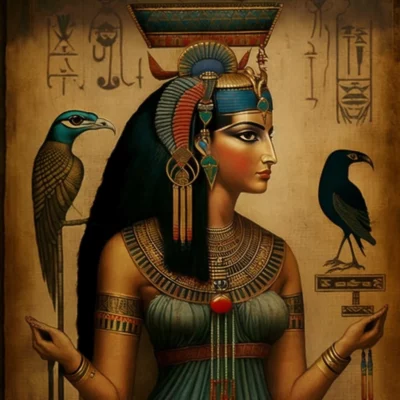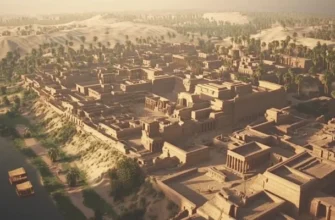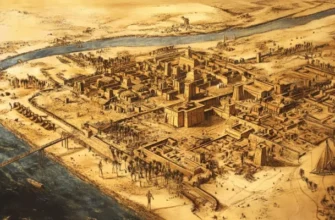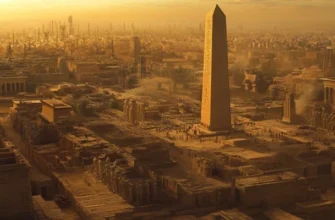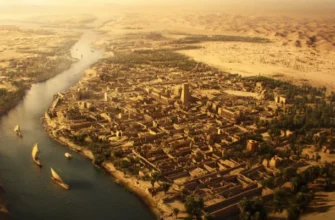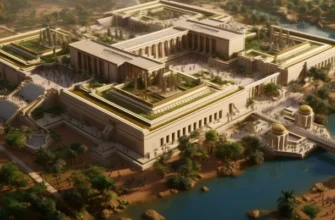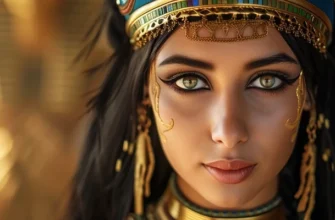The Egyptian goddess Maat was considered a symbol of order and justice in Egyptian mythology. She was the goddess of law and order and truth, who was considered the spiritual center of Egyptian society. Maat was depicted with scales and a feather, which was considered a symbol of truthfulness and honesty. Her cult originated in the ancient Egyptian period and remained popular throughout Egyptian history. The cult of Maat played an important role in Egyptian society, particularly in the judicial system, where it was used to define law and order and justice. Today, the Maat is one of the most recognizable symbols of Egyptian mythology and remains an important element in modern culture.
- History of Maat in Egyptian mythology
- The origin of Maat
- The meaning of Maat in Egyptian mythology
- The development of the cult of Maat throughout the history of Egypt
- The image of Maat and its symbolism
- Appearance of Maat
- Symbolism of scales and feathers in Maat images
- Attributes and paraphernalia of Maat
- The role of Maat in Egyptian society
- Practical use of the Maat cult in Egyptian society
- The social and political role of the Maat in Egyptian society
- Reflection of Maat in literature and art
- Modern perception of Maat
- The role of Maat in modern religious and spiritual practices
- Use of Maat in culture and media
- Conclusion.
History of Maat in Egyptian mythology
The Egyptian goddess Maat has a long history in Egyptian mythology. Her name means “truth” or “truth” and comes from the root “m” in Egyptian, which means “to be steady, unchanging”.
The cult of Maat is known to have originated in the ancient Egyptian period (ca. 2686-2181 BC). Maat was associated with justice and order in the universe, as well as with law and order in human society. The goddess was depicted as a woman with scales in one hand and a feather in the other.
During the New Kingdom period (ca. 1550-1070 BC), Maat became increasingly associated with the pharaonic government and the judicial system. It was believed that the goddess Maat came into the world to establish order and restore justice.
During the Third Intermediate Period (ca. 1070-712 BCE), Maat became more associated with moral values and ethics. It was believed that a person should follow Maat to be acceptable in the eyes of the gods.
The influence of Maat in Egyptian culture is felt both in ancient times and in our days. Its symbolism is used in modern esoteric movements and decorative elements associated with Egyptian mythology.
The origin of Maat
The Egyptian goddess Maat was one of the most ancient and defining deities in Egyptian mythology. It is believed that Maat appeared in ancient times when people began to realize the need for truth, order, and justice in society.
There are several versions of the origin of Maat. One of them connects Maat with the elements and natural phenomena, such as earthquakes, public snakes, and storms. It was believed that Maat appeared to establish order in these unpredictable forces of nature.
Another version connects Maat with human relationships. It was believed that Maat appeared to bring order, justice, and truth to the relationships between people, as well as between man and the gods.
Regardless of which version is correct, Maat became one of the most defining symbols of Egyptian mythology. It has become the embodiment of order and justice in the entire universe, as well as in human life.
The meaning of Maat in Egyptian mythology
Ma’at in Egyptian mythology played a key role in ensuring order, justice, and harmony throughout the universe. She embodied the ideals that should guide the behavior of people and gods.
Maat was an important component of all spheres of Egyptian life. She acted as a judge in the afterlife, deciding the fate of the souls of the dead. Maat was also a symbol of justice, and was often depicted together with the god Thoth, the god of wisdom, to ensure a fair decision in disputes between the gods.
In royalty, Maat played an important role as a symbol of legitimate authority. The pharaohs were considered to be her incarnation and had to adhere to her principles in their rule. Because of this, Maat became one of the most important deities in royalty and was depicted on many royal religious objects.
In general, Maat was a symbol of order and harmony in all aspects of Egyptian life. It reminded people of the importance of truthfulness, order, and justice in everything they did. Therefore, Maat is one of the most defining symbols of Egyptian mythology and its influence can be seen in many aspects of Egyptian life.
The development of the cult of Maat throughout the history of Egypt
The cult of Maat appeared in ancient Egyptian history and developed over many centuries. At first, Maat was simply a symbol of order and justice, but over time, she became a goddess to whom sacrifices were made and prayed.
Over time, the cult of Maat became more and more popular among the Egyptians, especially during the reign of the Pharaonic dynasty with Osiris in its pantheon of gods. At this time, Maat played an important role in justice, and her images appeared on many official state facilities.
During the royal era, the cult of Maat became even more popular. The pharaohs, who were supposed to represent Maat on earth, were often depicted with her at religious and state sites. Its principles were incorporated into the laws and rules of behavior that governed the lives of people from all walks of life.
Over time, attitudes toward the cult of Maat changed. During the religious reform of Pharaoh Amenhotep IV (Egyptian Ekhnaton), Maat was pushed into the background, and the pharaoh introduced the cult of Aten, the goddess of light and justice. However, after the death of Ekhnaton, the cult of Maat was restored and became even more popular in the New Kingdom.
In the later period of Egyptian history, Maat continued to play an important role in the lives of Egyptians and was revered as a symbol of order and harmony. She was depicted on many religious and state objects, and was the subject of many rituals and ceremonies. However, with the advent of Christianity in Egypt, the cult of Maat disappeared from common use.
Today, the cult of Maat can be found only among modern neo-Opagan movements that seek to return to the ancient pantheon of Egyptian gods and goddesses. In these movements, Maat is a symbol of order, justice, and harmony, and finds its place in various rituals and magical practices.
Maat is an important symbol of ancient Egypt, reflecting the importance of order, justice and harmony in people’s lives. Its cult developed over many centuries, playing an important role in justice and government. Today, the cult of Maat remains an important element not only of ancient history but also of contemporary neo-pagan practice.
The image of Maat and its symbolism
The image of Maat in Egyptian mythology was depicted as a woman with a feather on her head, symbolizing writing and knowledge, and a scale in her hands, indicating her role in weighing the souls of the dead. Sometimes she was depicted with a falcon’s head, which linked her to the god Ra.
Maat’s symbolism included elements such as a feather, a scale, the sun, and various animals, including bulls and lions. The feather symbolized truth and justice, the weight symbolized balance and order, and the sun symbolized wisdom and heavenly power. Animals, which were often depicted next to Maat, played the role of its patrons and symbolized important aspects such as strength, resilience, and protection.
The concept of “Maat” can also be used in various contexts in the modern world, including psychology and spirituality. In this case, it can indicate the ideal of order and harmony in human life, as well as the importance of relationships with other people and with nature.
Appearance of Maat
In Egyptian mythology, Maat was usually depicted as a woman with a feather on her head and a weight in her hands. Her image was often accompanied by other symbols that emphasized her role in maintaining order and justice. For example, Maat may be depicted next to the sun symbol, indicating her celestial origin and importance in ensuring balance in nature. Maat is also often depicted next to a bull or lion, which symbolize strength and resilience.
Egyptian art historians have noted that depictions of Maat differed slightly depending on the era and region. For example, in ancient manuscripts, Maat was depicted with a narrow face and a long nose, indicating her bird-like origin, and in the Middle Kingdom, her image took on a more human form. In the New Kingdom, Maat was depicted in many different ways, reflecting the various roles and functions that were attributed to her. However, despite all these differences, Maat remained a symbol of order, justice, and balance in Egyptian mythology.
Symbolism of scales and feathers in Maat images
The scales and the feather are two of the most common symbols of Maat in images. The scales symbolize balance and justice, and the feather symbolizes truth and intellectual wisdom.
Typically, Maat was depicted with a scale in one hand and a feather on her head or in her other hand. Maat’s weight had two bowls, one of which was empty and the other filled. This symbolized the balance that must be maintained in all matters related to justice and order. The idea was to act in such a way that the “heart” would find balance with the pen of truth during the difficult judicial process after death.
The feather, usually depicted on the head of Maat, was considered a symbol of truth and intellectual wisdom. According to Egyptian mythology, during life a person was supposed to strive for knowledge and wisdom, and after death his heart was weighed against the feather of Maat at a court in the suburbs of Osiris.
Thus, the scale and the feather in Maat’s images symbolize balance, justice, truth, and intellectual wisdom, which were extremely important to Egyptian culture.
Attributes and paraphernalia of Maat
In addition to the scales and the feather, Maat had other attributes and paraphernalia that symbolized different aspects of her character and power.
One of Maat’s main attributes is the boa constrictor, which was often depicted on her head. The boa symbolized the harmony and balance that Maat embodied.
Maat was also depicted with a stitch or rod in her hand, which were symbols of power and control. This emphasized her role in maintaining order in the royal court and in the country as a whole.
Sometimes Maat was depicted with the Ankh sign in her hand, which symbolized life and eternity, emphasizing her importance in the afterlife.
Maat is also depicted as a woman with wings. This indicates that Maat was also the goddess of the sky and air, who provided protection over the kingdom.
In general, Maat’s attributes and paraphernalia provide additional details about her properties and role in Egyptian mythology, which help to better understand her significance in the society of the time.
The role of Maat in Egyptian society
Maat played an important role in Egyptian society. It was a symbol of order, justice, and harmony. It can be found in various spheres of life, including jurisprudence, politics, art, and religion.
Maat played an important role in the judicial system. In Egyptian mythology, it is said that after death, the soul is subjected to a test during which the heart is weighed against the pen of Maat. If the heart was light, the soul could pass to the afterlife. This shows how important Maat was in determining justice and order in Egyptian society.
Maat also played an important role in politics. The kings of the Egyptian state were considered gods and were obliged to observe the Maat. They believed that by fulfilling their duties in accordance with the Maat, they ensured harmony and order in the country.
In art, Maat was depicted on the walls of temples and tombs, where her role was to embody order and harmony in the world. She was often depicted in company with the god Ra, the sun god, and other deities representing different aspects of life.
Thus, Maat played an important role in Egyptian society as a symbol of order and justice. It reflects the basic principles that formed the basis of the spiritual life of Egypt at that time, which regulated people’s lives and behavior.
Practical use of the Maat cult in Egyptian society
The Maat cult played a practical role in Egyptian society, ensuring order and justice in various aspects of life. It was important for justice, where Maat acted as a guardian of order and equality before the law. In addition, the cult of Maat was associated with the rule of the pharaohs, who had to ensure order and justice in their domains.
The cult of Maat also played an important role in interpersonal relations, ensuring peace and harmony between people. Maat was a symbol of kindness, truth, and relationships with one’s neighbors, and her cult contributed to the formation of moral norms and values in Egyptian society.
In addition, the cult of Maat was of great importance in the sphere of religious life. Maat was recognized as the protector of order and balance in nature, as well as responsible for the fate of the souls of the dead. Her cult was associated with various religious rites, including the rite of weighing the heart of the deceased on the Maat scale in the underworld.
Thus, the cult of Maat was important for the functioning of Egyptian society, ensuring order and justice in various spheres of life. It was important for justice, politics, interpersonal relations, and religion.
The social and political role of the Maat in Egyptian society
In Egyptian society, the Maat played an important role not only in religious practices but also in social and political life. The principles of the Maat were at the heart of the Egyptian social and legal system, which was based on equality, order, and justice. According to the ideals of the Maat, every member of society must fulfill his or her duties and abide by the laws to ensure harmonious cooperation between all parts of society.
The rulers of Egypt also played an important role in maintaining the Maat. They were considered deities on earth and were responsible for maintaining order and stability in the country. Their decisions and actions had to be in line with the ideals of the Maat to ensure the prosperity of the country and its people.
In addition, the Maat was important in political relations with other countries. Egyptian rulers believed that stable and fair relations between nations could be achieved only if the ideals of the Maat were respected. Thus, when signing international treaties, Egyptian diplomats affixed seals with the image of the Maat, which symbolized their agreement with the principles of order and justice.
In addition, Maat played an important role in the rule of the pharaohs. Pharaohs were considered the highest representatives of the gods on earth and were responsible for ensuring order and justice in the country. Consequently, they had to follow the Maat in their actions and decisions.
For example, the adoption of a new law or the appointment of a new official was carried out during a ceremony during which the pharaoh took a vow to follow the Maat and protect the rights of the people. There were also special courts that heard cases related to violations of the Maat.
In turn, the people of Egyptian society had to follow the principles of the Maat in their daily actions and relationships with other people. This was reflected in religious rites and ceremonies, as well as in laws that were adopted on the basis of Maat principles.
Overall, the Maat played an important role in Egyptian society as a symbol of order, justice, and harmony. Its principles influenced all aspects of life in ancient Egypt and became an important element of the culture and religion of this civilization.
Reflection of Maat in literature and art
Ma’at is an ancient Egyptian goddess who represents order, justice, and truth. She was depicted as a woman with feathers on her head, symbolizing lightness and truthfulness, with a plain maidenly figure to help reflect her purity.
Ma’at is often mentioned in ancient Egyptian literature, such as the Book of the Dead, where she appears as a goddess who weighs the heart of the deceased on a golden scale with a feather at one end to determine whether the deceased deserves eternal life in the afterlife.
Maat was also depicted in many ancient Egyptian artworks, including statues, reliefs, and murals. For example, the temple of Amun-Ra in Karnak has statues of Maat that depict her with feathers on her head and holding scales.
In addition, Maat is mentioned in many contemporary works such as novels and movies. For example, in Daniel Keyes’ novel The Tattooed Heart, Maat is one of the central symbols representing justice and harmony.
Modern perception of Maat
Maat is one of the most important goddesses of ancient Egypt, symbolizing order, harmony, and justice. In modern perception, Maat continues to have significance as a symbol of justice and equality, which is reflected in various aspects of life.
In contemporary culture, Maat is sometimes perceived as a symbol of justice and legality. Her image can be found on the logos of judicial institutions and law firms. Maat is also an important figure in contemporary spiritual movements.
In the context of the modern world, Maat can also be interpreted as an important aspect of human interaction with nature and the world around us. Its principles, such as balance and harmony, can serve as a guide to achieving sustainable development and preserving natural resources.
In general, Ma’at and its principles continue to be important to humanity in the modern world as symbols of order, harmony, justice, and equality.
The role of Maat in modern religious and spiritual practices
Maat is the goddess of truth, order, justice, and harmony in Egyptian mythology. Her role in the history and culture of Ancient Egypt was great, and today she continues to influence the religious and spiritual practices of many people around the world.
One of the most well-known heirs to the Egyptian tradition, which includes Maat, is the modern Celtic religion. This religion, also known as Neteru, is based on ancient Egyptian traditions and culture, but it is evolving and discovering new aspects of these traditions. Believers of the Celtic religion honor Maat as the goddess of order, truth, and justice, and she is often one of the main deities invoked.
In some modern spiritual practices, including those not related to the Egyptian tradition, Maat is used as a symbol of harmony, balance, and correctness. For example, in New Age and other spiritual movements, Ma’at can be used as a symbol of understanding cosmic harmony and order in the universe, as well as a reminder of the importance of understanding and adhering to ethical principles and justice.
Use of Maat in culture and media
Maat is an ancient Egyptian goddess who was associated with justice, order and truth. She was depicted as a woman with a feather in her hand, indicating her role in weighing the souls of the dead on a scale in the afterlife.
The use of Maat’s image can be seen in various cultural and media contexts. For example, in movies and video games, her image can be used to create an impression of mysticism or exoticism. In music, Maat can be depicted through lyrics, images in music videos, and album covers.
Maat can also be used as a symbol of social and political justice in different countries. For example, her image is used in the coats of arms and flags of some African countries that became independent from European colonizers. In many local communities, you can also see images of Ma’at on walls or as a symbol of government institutions.
In general, the use of the Maat image in culture and media can be varied and depends on the context in which it is used. However, this image remains popular in the world of art and culture, and continues to inspire people around the world.
Conclusion.
Maat is an ancient Egyptian goddess symbolizing justice, order, and truth. She played an important role in ancient Egyptian religion and culture, and remains an important figure in modern culture and art.
Images of Maat are used in various contexts, as a symbol of social and political justice, as well as to create an impression of mysticism and exoticism in movies and video games.
The principles that Maat represented, such as justice, order, and truth, can be applied in the modern world. Ma’at is a reminder that it is important to adhere to the principles of justice and order in all spheres of life to ensure harmony and peace in society
